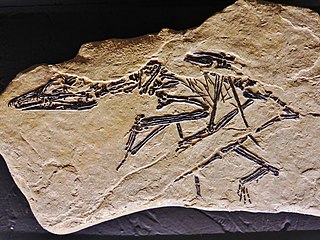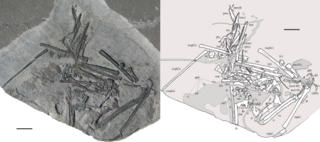
Eudimorphodon was a pterosaur that was discovered in 1973 by Mario Pandolfi in the town of Cene, Italy and described the same year by Rocco Zambelli. The nearly complete skeleton was retrieved from shale deposited during the Late Triassic, making Eudimorphodon one of the oldest pterosaurs known. It had a wingspan of about 100 centimeters (3.3 ft) and at the end of its long bony tail may have been a diamond-shaped flap like in the later Rhamphorhynchus. If so, the flap may have helped it steer while maneuvering in the air. Eudimorphodon is known from several skeletons, including juvenile specimens.

Preondactylus is a genus of long-tailed pterosaurs from the Late Triassic that inhabited what is now Italy. It contains a single known species, Preondactylus buffarinii, which was discovered by Nando Buffarini in 1982 at the Forni Dolostone near Udine in the Preone valley of the Italian Alps.

Peteinosaurus was a prehistoric genus of pterosaur. It lived in the late Triassic period in the late Norian age, and at a wingspan of around 60 cm (24 in), was one of the smallest and earliest pterosaurs, although other estimates suggest a wingspan of up to 1 m (3.3 ft).

Pterosauromorpha is one of the two basic divisions of Ornithodira that includes pterosaurs and all taxa that are closer to them than to dinosaurs and their close relatives. In addition to pterosaurs, Pterosauromorpha also includes the basal clade Lagerpetidae and some other Late Triassic ornithodirans.

Gallodactylidae is a group of pterosaurs within the suborder Pterodactyloidea. Gallodactylids differed from other related pterosaurs in several distinct features, including fewer than 50 teeth present only in the jaw tips, and rounded crests present on the rear portion of the skull and jaws but not near the ends of their snouts. At least some species possessed jaw flanges, possibly used to bissect hard-shelled prey.
Caviramus is a genus of caviramid pterosaur from the Late Triassic lower Kössen Formation of the Northern Calcareous Alps of Switzerland.
Eoazhdarcho is a genus of azhdarchoid pterodactyloid pterosaur named in 2005 by Chinese paleontologists Lü Junchang and Ji Qiang. The type and only known species is Eoazhdarcho liaoxiensis. The fossil was found in the Aptian-age Lower Cretaceous Jiufotang Formation of Chaoyang, Liaoning, China.

Ornithocheiroidea is a group of pterosaurs within the extinct suborder Pterodactyloidea. They were typically large pterosaurs that lived from the Early to Late Cretaceous periods, with fossil remains found all over the world except Antarctica.

Dsungaripteroidea is a group of pterosaurs within the suborder Pterodactyloidea.

Azhdarchoidea is a group of pterosaurs within the suborder Pterodactyloidea, more specifically within the group Ornithocheiroidea. Pterosaurs belonging to this group lived throughout the Early and Late Cretaceous periods, with one tentative member, Tendaguripterus, that lived in the Late Jurassic period. The largest azhdarchoids include members of the family Azhdarchidae, examples of these are Quetzalcoatlus, Hatzegopteryx, and Arambourgiania. The Azhdarchoidea has been recovered as either closely related to the Ctenochasmatoidea, as the sister taxon of the Pteranodontoidea within the Ornithocheiroidea, or within the Tapejaroidea, which in turn was also within the Ornithocheiroidea.

Raeticodactylus is a genus of non-pterodactyloid pterosaur from the late Norian-early Rhaetian-age Upper Triassic lower Kössen Formation of the central Austroalpine of Grisons, Switzerland. It is known from holotype BNM 14524, a single disarticulated partial skeleton including an almost complete skull, found in August 2005. This genus was named and described in 2008 by its discoverer Rico Stecher; the type species is Raeticodactylus filisurensis. The specific name refers to Filisur.

Carniadactylus is a genus of pterosaur which existed in Europe during the Late Triassic period. The genus contains a single species, Carniadactylus rosenfeldi.

Novialoidea is an extinct clade of macronychopteran pterosaurs that lived from the latest Early Jurassic to the latest Late Cretaceous, their fossils having been found on all continents except Antarctica.

Eopterosauria is a group of basal pterosaurs from the Triassic, which form their own clade. The term was first used in Andres et al. (2014) to include Preondactylus, Austriadactylus, Peteinosaurus and Eudimorphodontidae. Inside the group were two other new clades, Preondactylia, which included Preondactylus and Austriadactylus, and Eudimorphodontoidea, to include Eudimorphodontidae and Raeticodactylidae. Eopterosauria was defined as "the least inclusive clade containing Preondactylus buffarinii and Eudimorphodon ranzii". The specimen BSP 1994, previously assigned to Eudimorphodon, was named the separate taxon Austriadraco in 2015, and assigned to the new family Austriadraconidae, but further classification was not described. The following phylogenetic analysis follows the topology of Andres et al. (2014).

Eudimorphodontidae is an extinct family of early pterosaurs from the Late Triassic of Europe. It was named by Peter Wellnhofer in 1978 to include Eudimorphodon ranzii. Some phylogenetic analyses suggested that Eudimorphodontidae is a junior synonym of Campylognathoididae, however more comprehensive analyses found Eudimorphodontidae to be basal to Macronychoptera that includes Campylognathoididae and more derived pterosaurs (Breviquartossa). Wang et al. (2009) found Eudimorphodontidae to include six species, but they didn't defined the clade. Brian Andres define Eudimorphodontidae and found Peteinosaurus to be most closely related to it. Furthermore, he found monophyletic Eudimorphodon clade, and defined two subfamilies within Eudimorphodontidae. The Eudimorphodontinae includes all taxa more closely related to Eudimorphodon ranzii than to Raeticodactylus filisurensis while the Raeticodactylinae includes all taxa more closely related to Raeticodactylus filisurensis than to Eudimorphodon ranzii. More recently, Raeticodactylus and Caviramus were moved into their own family, Raeticodactylidae. The below cladogram follows that analysis.

Anhangueria is a group of pterosaurs belonging to the clade Pteranodontoidea. Fossil remains of this group date back from the Early to Late Cretaceous periods, around 140 to 92.5 million years ago. Anhangueria was named by paleontologists Taissa Rodrigues and Alexander Kellner in a review of Ornithocheirus species in 2013, they defined the clade as a branch-based taxon consisting of all pteranodontoids more closely related to Anhanguera blittersdorffi than to Istiodactylus latidens and Cimoliopterus cuvieri.
Arcticodactylus is a genus of basal pterosaur living during the Late Triassic in the area of present Greenland. Its only species was previously attributed to Eudimorphodon, and its closest relatives may have been Eudimorphodon or Austriadraco.
Austriadraco is a genus of pterosaur living during the Late Triassic in the area of present Austria. Its only species—Austriadraco dallavecchiai—was previously attributed to Eudimorphodon, and its closest relatives may have been Eudimorphodon or Arcticodactylus.
Raeticodactylidae is a family of eudimorphodontoid eopterosaurian pterosaurs that lived in Switzerland during the Late Triassic. The family includes Caviramus, and the type genus Raeticodactylus, which are both known from the Kössen Formation, around 205 mya. Raeticodactylidae was first used in 2014 by Andres et al., as a group of all pterosaurs closer to Raeticodactylus than Eudimorphodon. The following phylogenetic analysis follows the topology of Andres et al. (2014).

Seazzadactylus is a basal pterosaur genus that lived during the late Triassic in the area of present Italy.




























